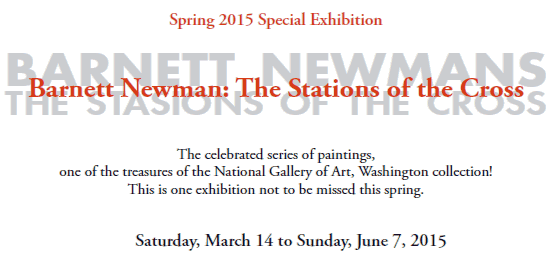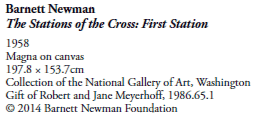
The exhibition was
organized by the National Gallery of Art, Washington,
in association with Miho Museum. |
 |

|
The renowned American Abstract Expressionist Barnett
Newman painted his series The Stations of the Cross
over a period of eight years, and it is shown here alongside
Be II, all 15 paintings appearing together for the first
time in Asia. From a distance they may appear to be cold,
inorganic designs, but you are in for a surprise when you
encounter the canvases face to face. |
The true theme of the series is concealed in its subtitle, Lema sabachthani (Why have you forsaken me?)-the words cried out by Jesus on the cross. Newman wrote of Lema sabachthani, “This is the Passion. This outcry of Jesus. Not the terrible walk up the Via Dolorosa, but the question that has no answer… [that] has been with us so long - since Jesus - since Abraham - since Adam - the original question.” What is this “question that has no answer”? Newman said of the unspeakable tragedies that occurred during his lifetime - of Auschwitz, of Hiroshima ”- that humanity had finally arrived at the tragic place foretold by the ancient Greeks two thousand years earlier. The critic Taki Koji stated that Lema sabachthani was, “to Newman… the anguished cry of human beings faced with the insoluble dilemma of the violent world they themselves created.” Taki went on to say that, “during the eight years Newman spent on the series… there is no doubt that he felt his mission as an artist was to transcend this world of tragedy through the unique power of painting.” (The two quotes above are translated from the Japanese text by Taki Koji, Exploration of Barnett Newman: Artist of a World Without Myth, Iwanami Shoten, 1994.) |
|
One of the great painters of the 20th century, Barnett Newman stands alongside Jackson Pollock, Mark Rothko and others as a core figure in American Abstract Expressionism. This movement, which emerged in New York after World War II, heralded the gravitational shift of the art world from Paris to New York. It is seen as the point of departure for genuine homegrown American art, and indeed for contemporary art as we know it today. Among the mid-century American abstractionists, Newman is noted for the contemplative and spiritual nature of his work, which focuses not on painterly techniques and textures, but on essential and existential meaning. Newman grappled head on with the task of expressing the sublime through art in a contemporary world without myth. |
||
 |
 |
 |
|
The Stations of the Cross at the National Gallery of Art, Washington (partial view)
(in the exhibition Seven American Masters, June 4 -November 15, 1986).
Photo by Kathleen Buckalew. National Gallery of Art, Washington, Gallery Archives
(in the exhibition Seven American Masters, June 4 -November 15, 1986).
Photo by Kathleen Buckalew. National Gallery of Art, Washington, Gallery Archives